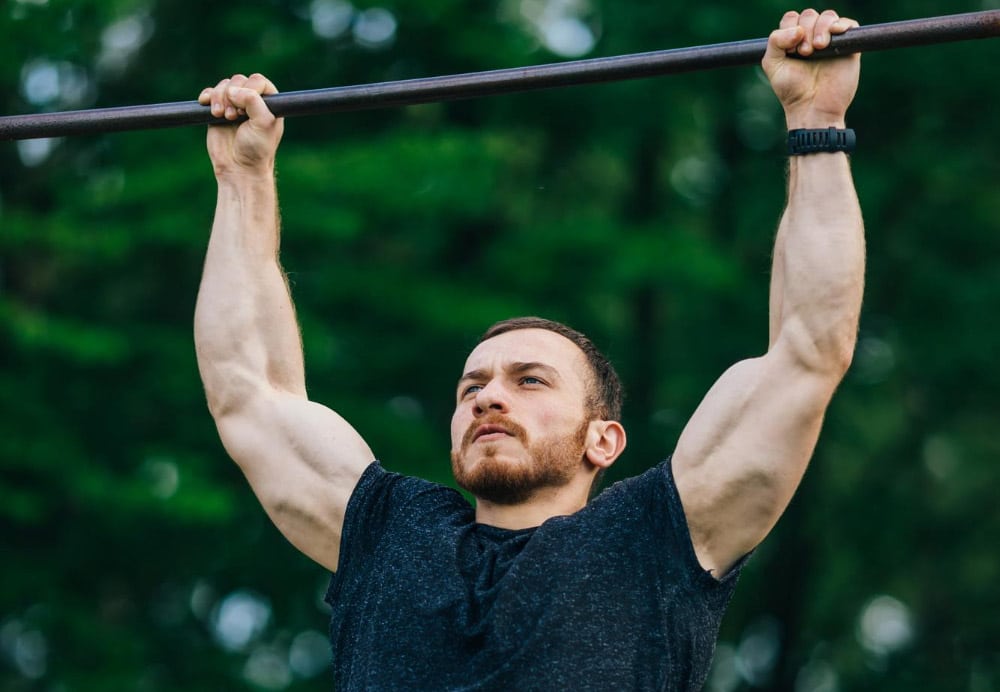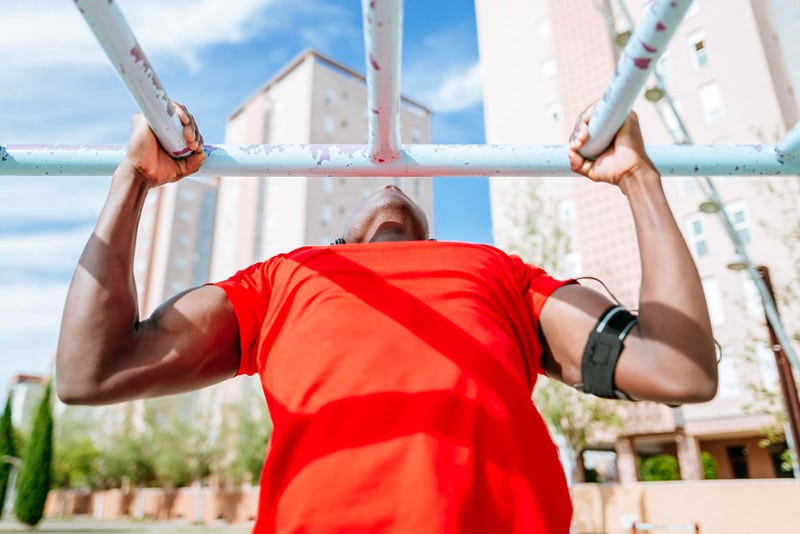As someone who’s into fitness, you’re probably already familiar with pull-ups and chin-ups.
They’re great exercises for strengthening your upper body, especially your back and biceps.
But did ya know there are several different types of pull-ups and chin-ups that can challenge you in different ways and help to target specific muscles?
I’ve got all the deets on pull-ups and chin-ups variations so you can start working these variations your training routine.
Why Pull-Ups and Chin-Ups Matter

Before we jump into the different variations, it’s essential to understand why pull-ups and chin-ups are so important in the first place.
Pull-ups and chin-ups are compound exercises, meaning they work on multiple muscle groups all at the same time.
These exercises engage your back, arms, shoulders, and even your core, offering a comprehensive upper-body workout.
They also don’t require fancy equipment – just a sturdy bar and your body weight.
But the real beauty lies in their variations, which can help you target different muscles and keep your workouts interesting and challenging.
Different Variations of Pull-Ups
Take a look at some of the most common, and most effective, variations of pull-ups:
- Wide Grip Pull-Ups: In this variation, your hands are placed further apart than the standard pull-up. This wider grip puts more emphasis on the lats and the rhomboids in your back, making it a great way to sculpt those back muscles.
- Close Grip Pull-Ups: Here, your hands are closer together than in the standard pull-up. This variation shifts some of the work from your lats to your biceps and middle back, providing a nice bicep workout while still engaging your back muscles.
- Commando Pull-Ups: In this variation, you grip the bar with your hands facing each other. As you pull yourself up, you move your head to one side of the bar, then the other, engaging your core and testing your coordination.
- Neutral Grip Pull-Ups: For this variation, you’ll need a bar with parallel handles. The palms of your hands should be facing each other, which can be more comfortable for your wrists and shoulders. This variation also works your brachialis muscle, located underneath your biceps.
- Archer Pull-Ups: In this variation, as you pull yourself up, you keep one arm straight and rely on the other to do most of the pulling. This style focuses more intensely on one side of your upper body at a time, similar to a one-arm pull-up but less difficult.
- Typewriter Pull-Ups: A cousin to the Archer Pull-Up, the Typewriter involves pulling yourself up and then moving horizontally from side to side. This variation gives a serious workout to your arm and shoulder muscles while also testing your endurance.
- Behind-The-Neck Pull-Ups: This version involves pulling your body up so the bar is behind your neck instead of in front of it. This variation focuses on your shoulder muscles and the upper portion of your lats, but it should be performed carefully to avoid injury.
- Clapping Pull-Ups: This advanced variation involves pulling yourself up with enough force that you can briefly release the bar when you’re at the top of the movement to clap your hands together. This version requires and also builds explosive power, grip strength, and body control. It’s crucial to master the standard pull-up before attempting this variation.
- L-Sit Pull-Ups: In this variation, you place your legs just straight out in front of you in an L-shape as you perform your pull-ups. This variation not only challenges your upper body but also engages your core to a higher degree.
- Muscle-Ups: This advanced move starts with a pull-up but continues with you pushing your body above the bar as in a dip. It’s a full upper-body workout that requires significant strength and coordination.
Remember, it’s always essential to use good form and ensure you’re ready for the level of difficulty offered by the variation you choose.
Be careful in the gym, listen to your body, and don’t rush into more challenging variations without being prepared.
As always, it’s a good idea for ya to consult with a fitness professional when trying new exercises, especially advanced variations.
Different Variations of Chin-Ups
And now, let’s move on to some effective variations of chin-ups:

- Standard Chin-Up: The classic chin-up has your palms facing towards you. This variation puts more emphasis on those biceps, making it a great arm workout.
- Underhand Close Grip Chin-Up: By moving your hands closer together with palms facing you, this variation increases the emphasis on your biceps even more.
- Mixed Grip Chin-Up: This is where one palm faces you and the other faces away. It’s a unique challenge that can help improve grip strength and adds an asymmetrical aspect to your workout.
- Weighted Chin-Up: If you’re looking to take your chin-up game to the next level, try adding a weight belt. It adds resistance, making the exercise more challenging and boosting muscle growth and strength.
- One-Arm Chin-Ups: This is a more advanced version of the chin-up and focuses the effort on one side of your body. It requires considerable arm and shoulder strength, and shouldn’t be attempted until you are comfortable with the standard chin-up.
- Ring Chin-Ups: If you have access to gymnastic rings, this is a great variation to try. The rings allow for a more natural movement of the wrists and shoulders. It also requires more stabilisation from your muscles, making it a more challenging and rewarding workout.
- Towel Grip Chin-Ups: In this variation, you drape two towels over the bar and grip these instead of the bar itself. This variation is fantastic for improving grip strength, an often overlooked but crucial aspect of overall fitness.
- Around-The-World Chin-Ups: This variation involves pulling yourself up, but instead of just going straight up and down, you move in a semi-circle from one side to the other. This tests and builds your body control and is an awesmome way to mix in some variety to your workout.
- Eccentric Chin-Ups: Also known as negative chin-ups, this version focuses on the downward phase of the movement. You get started in the top position and then lower yourself as slowly as possible, maximising muscle tension. This is an excellent variation for beginners who struggle with the upward phase of chin-ups.
- Plyometric Chin-Ups: These are similar to clapping pull-ups but done with an underhand grip. You pull yourself up with enough force to actually let go of the bar at the top, clap, and then catch the bar again. It’s a challenging variation that improves explosive power and should be attempted with caution.
Remember, it’s always key to maintain correct form and avoid rushing into more challenging variations until you’re ready.
Always consult with a fitness professional when introducing new exercises, especially advanced ones, to ensure safety and effectiveness.
Why You Need To Do Different Types Of Pull-Ups And Chin-Ups
Pull-ups and chin-ups are foundational exercises in strength training and calisthenics.
But why should you consider varying the types of these exercises in your workout regimen? There are several compelling reasons:

Muscle Activation
Different types of pull-ups and chin-ups engage various muscles to different degrees.
Standard pull-ups focus heavily on the lats (back muscles), while chin-ups engage the biceps more intensely.
Varying your workout with these exercises can ensure a balanced upper-body strength.
Overcoming Plateaus
If you’re finding that your progress has stalled with a standard pull-up or chin-up, introducing variations can help you break through that plateau.
By changing the grip or the movement, you’re challenging your muscles in a new way, which can stimulate further growth and strength development.
Injury Prevention
Overuse injuries can occur when you repeatedly stress the same muscles and joints without adequate recovery.
By varying the types of pull-ups and chin-ups you do, you spread the load across different muscle groups and joints, which ends up reducing the risk of overuse injuries.
Improved Grip Strength
Different variations of pull-ups and chin-ups can improve your grip strength.
For example, the towel grip pull-up is a great way to enhance your grip strength, which can benefit you in other lifts and physical activities.
Functional Strength and Mobility
Different pull-up and chin-up variations can also improve your functional strength and mobility, meaning the strength and flexibility that support everyday movements.
For instance, commando pull-ups require and build a high level of core stability, which is essential for making sure you maintain good posture and preventing back pain.
Mental Engagement
Varying your workout can keep things interesting and challenging.
When you end up doing the same exercises in the same way over and over, eventually monotony sets in.
Mixing things up with different pull-up and chin-up variations can keep you mentally engaged and motivated in your workouts.
Varying your pull-up and chin-up routine is a beneficial way to enhance your overall physical fitness.
However, always ensure that your form is correct and that you’re physically ready for the level of difficulty posed by each variation.
If you’re unsure, it’s always wise to seek advice from a fitness professional.
How to Incorporate Pull-Up and Chin-Up Variations Into Your Training
If you’ve decided to bring more variety into your training regimen with pull-up and chin-up variations, here’s some ways you can incorporate these exercises into your program.

Start with the Basics
If you’re new to pull-ups or chin-ups, start with the basics.
Begin with standard pull-ups and chin-ups, and once you can perform several reps with good form, start introducing the variations.
Use Assisted Variations If Needed
If you’re unable to perform full pull-ups or chin-ups, you can use assisted variations.
You can use a resistance band, an assisted pull-up machine, or even an exercise partner.
This can help you build the strength needed to eventually perform the exercises without assistance.
Cycle Through Variations
Instead of doing the same type of pull-up or chin-up every workout, try cycling through the variations.
This could mean doing a different variation each workout, each week, or even each set.
This helps ensure balanced muscle development and keeps your workouts interesting.
Integrate Into Your Upper Body or Pull Days
If you’re following a training split, pull-ups and chin-ups can be incorporated into your upper body or pull days.
They can serve as the main compound exercise to start the workout, or as a supplementary exercise after other lifts.
Use as a Finisher
For a challenging finish to your workout, try doing pull-ups or chin-ups to failure.
This means performing as many reps as you can until your muscles can’t perform another with proper form.
Add Weight for Extra Challenge
Once you’ve mastered bodyweight pull-ups and chin-ups and can perform many reps with ease, consider adding weight for an extra challenge.
This can be done using a weighted vest, a dip belt, or a dumbbell between your legs.
Practice Regularly
Like any exercise, the key to getting better at pull-ups and chin-ups is consistency.
Aim to include them in your workouts at least once or twice a week.
Don’t forget that pull-ups and chin-ups are intense exercises that require a lot of strength.
Always prioritize form over the number of reps or the amount of weight.
If you’re unsure about your form, seek advice from a fitness professional.
And remember to listen to your body and adjust your training as needed to avoid overuse injuries.
Different Types Of Pull-Up And Chin-Up Grips
Pull-ups and chin-ups are incredibly versatile exercises, partly due to the different grip variations you can use.
These variations can target different muscles and make your workouts more diverse and challenging.
Here, we’ll break down the most common grip types.

Overhand Grip (Pronated)
This is the standard grip for doing a pull-up.
Your palms are faced away from you, and your hands are generally shoulder-width apart or a little wider.
This grip primarily targets your latissimus dorsi (the largest muscles in your back), but it also engages your biceps and several muscles in your shoulders and forearms.
Underhand Grip (Supinated)
The underhand grip is used for chin-ups. Your palms are facing towards you, usually with your hands closer together.
This grip puts more emphasis on the biceps, while the back muscles are still heavily engaged.
Some people find chin-ups to be more accessible than pull-ups due to the additional bicep involvement.
Neutral Grip
In the neutral grip, your palms face each other.
This grip is typically more comfortable for the wrists and shoulders and allows for a different muscle engagement pattern.
Neutral grip pull-ups still target your back and biceps, but they also work your brachialis muscles, located underneath your biceps, and your brachioradialis, a muscle of the forearm.
Mixed Grip
The mixed grip is when one hand uses an overhand grip and the other uses an underhand grip.
This grip is less common but can be beneficial for enhancing grip strength and adding an asymmetrical aspect to your workout, challenging your muscles in a new way.
Wide Grip
In the wide grip, your hands are placed wider than shoulder-width apart on the bar.
This grip changes the angle of the exercise, placing more emphasis on your lats and upper back muscles.
It can make the pull-up more challenging due to the decreased mechanical advantage.
Close Grip
With the close grip, your hands are closer together than shoulder-width.
This variation shifts more of the work to your biceps and the middle of your back, providing a slightly different muscle stimulus than the standard pull-up.
Towel Grip
The towel grip involves draping two towels over the bar and grabbing onto them instead of the bar itself.
This grip is not only a good change of pace, but it’s also a fantastic way to increase your grip strength.
Commando Grip
The commando grip has your hands positioned close together with one hand in front of the other, palms facing each other.
This grip can target different muscles and requires a good deal of core stability to maintain proper form.
Regardless of the grip you choose, maintaining proper form is key.
Varying your grip can be an awesome way to challenge your muscles in new ways while also keeping your workouts exciting and engaging.
Remember to listen to your body and modify or stop if you feel any discomfort beyond the usual workout fatigue.
Muscles Worked During Pull-Ups and Chin-Ups
Pull-ups and chin-ups are fantastic exercises for developing upper body strength and muscularity.
They’re compound movements, meaning they engage multiple muscle groups at once.
Here’s a closer look at the specific muscles involved:
Latissimus Dorsi
The latissimus dorsi, or lats, are the large muscles in your back, giving it the characteristic ‘V’ shape.
They’re the primary movers in pull-ups and chin-ups, responsible for the actual “pulling” motion.
Biceps Brachii
The biceps brachii are the muscles in the front of your upper arms.
They’re significantly engaged during chin-ups due to the underhand (supinated) grip, but they also play a role in pull-ups.
Brachialis and Brachioradialis
The brachialis is a muscle that lies underneath your biceps, while the brachioradialis is a muscle of the forearm.
These muscles are activated during both pull-ups and chin-ups, with neutral and overhand grips engaging the brachioradialis more.
Rhomboids and Trapezius
The rhomboids (between your shoulder blades) and trapezius (extending down the back of your neck and upper spine) are both worked during pull-ups and chin-ups.
They’re responsible for retracting and stabilizing the shoulder blades.
Deltoids
Your deltoid muscles (shoulders) are involved in pull-ups and chin-ups, specifically the posterior (rear) deltoids.
They assist in the pulling motion and help stabilize your shoulders.
Core Muscles
While not the primary target, your core muscles, including the rectus abdominis, obliques, and erector spinae, are engaged during pull-ups and chin-ups.
They help stabilize your body and prevent it from swinging.
It’s important to note that different variations of pull-ups and chin-ups will emphasize different muscles to varying degrees.
For instance, a wide-grip pull-up places more emphasis on the lats, while a chin-up engages the biceps more.
Always ensure you’re using proper form during these exercises to engage the muscles correctly and avoid injury.
And remember, the best exercise regimen is a varied one – so don’t forget to include other exercises targeting different muscle groups in your workout routine.
Final Word
Proper form is essential when doing pull-ups and chin-ups, regardless of the variation. Keep your body straight, engage your core, and avoid swinging or kipping.
Remember to breathe! It’s common to hold your breath during these exercises, but you really should be exhaling as you pull yourself up and inhaling as you lower yourself.
Lastly, don’t rush. These are challenging exercises.
It’s more important to perform them correctly than to do more reps. Start slow, focus on your form, and gradually increase your reps as you gain strength
